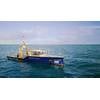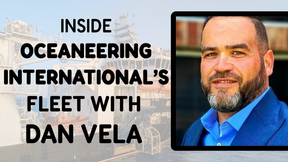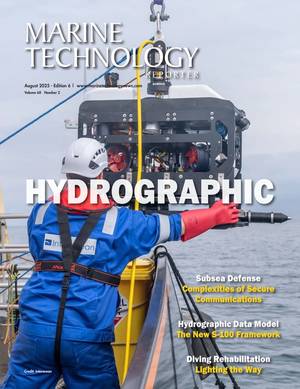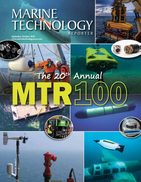URI Research Seeks to Learn About Deep Sea Organisms

URI’s Brennan Phillips prepares the rotary actuated dodecahedron sampling system before the final dive of the Designing the Future cruise in 2021. (Photos: Jovelle Tamayo/Schmidt Ocean Institute). © URI
Building upon previous research, University of Rhode Island Professor of Ocean Engineering and Oceanography Brennan Phillips and a multidisciplinary team of scientists will use cutting-edge technology to learn new information about fragile deep-sea organisms and possibly discover new species.
The team will receive $2.2 million over three years from the Ocean Shot Research Grant Program, an initiative to encourage bold research in ocean discovery and technology through the Sasakawa Peace Foundation’s Ocean Policy Research Institute, supported by The Nippon Foundation.
In addition to Phillips, the team is led by John Burns of the Bigelow Laboratory for Ocean Sciences, and includes Robert Wood from Harvard University, David Gruber from Baruch College, Kakani Katija from the Monterey Bay Aquarium Research Institute, and Dhugal Lindsay from the Japan Agency for Marine-Earth Science and Technology.
Phillips and the team will reimagine the novel, origami-inspired robotic encapsulation device used in the “Designing the Future” project by outfitting it with a biopsy tool, modeled on the biology of the mantis shrimp, that can non-destructively sample gelatinous organisms floating in the water.
The technology Phillips and his colleagues previously developed and used for the first time was chronicled by URI and in the journal Science Advances in 2024. The articles described the results of the first application of the device, which included the characterization of four deep-sea animals with unprecedented levels of detail, down to the genetic level.
The goal of the new device will be to enable “catch and release sampling,” where the researchers can enclose an animal in an underwater chamber and use various sensors and devices to collect tissue samples for genetic analysis before releasing the animal unharmed.
Phillips has a master’s degree in biological oceanography, so he knows more about biology than the average engineer. But to prepare for this project, he learned a great deal about genetic research. For example, to perform a proper biopsy of a deep-sea jellyfish, only a small amount of material is needed—about the amount of toothpaste you might squeeze onto your toothbrush, or less.
“The time we take to collect the specimen and preserve it also means a lot,” said Phillips. “If we can get the tissue into preservative within a minute or two of collecting it, we can get a full genome expression, including the ‘junk’ DNA that can tell you a lot about how the animal is stressed, what its metabolism is, etc. We’re trying to get the most amount of information from the smallest amount of tissue, so we need to take extreme steps to get that tissue into preservative immediately to ensure it makes it to the lab in its most pristine form. This takes place at depth, in the ocean— making it more challenging.”
Other members of the research team will design software to process the complex data produced by their cutting-edge imaging systems. The goal will be to develop new algorithms for processing multidimensional imaging data and artificial intelligence tools to automatically identify the animals they image. They will also deploy a new shadowgraph system that essentially takes pictures with shadows to capture the internal structure of the animals, which will help with taxonomic classification of new species.
While the project is in the conceptual planning stage, Phillips expects to have a working prototype in the laboratory by this winter. According to Phillips, the first expedition is likely to be in late 2026, somewhere in the South Atlantic Ocean.















 August 2025
August 2025



